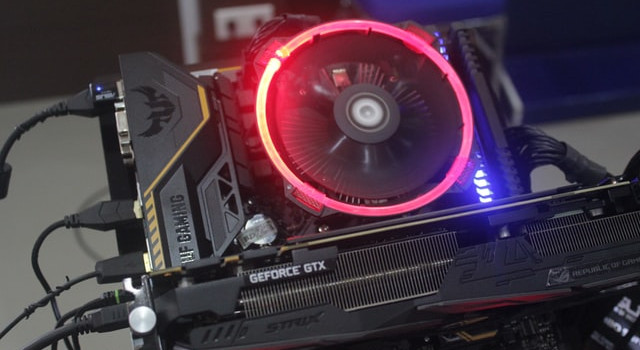TDP stands for Thermal Design Power. This is a term that you may have seen on component spec sheets, especially on CPUs and GPUs, referring to a numeral value of heat efficiency.
Well, the name does not exactly describe itself directly. True, power and performance (potential output) are directly related to each other. Keeping a component cool for optimal use requires some sort of measurement of how low it could get.
However, looking at how they are listed on spec sheets, we realize that it doesn’t really make much sense. 65 watts for cooling?
Does that mean anything lower would compromise performance? And how is this calculated for heat (as opposed to required electric power) dissipation anyway?
In this brief guide, we’ll try to clear up the confusion to reveal hopefully what TDP should really be.
Table of Contents
Hint: Actually, They are Both
The first thing that throws off anyone in a TDP reading is the unit used: watts. This unit is not exactly limited to electric power. But in the DIY PC space, “watt(s)” is almost universally used when referring to almost anything related to electric energy. This is the reason why when we refer to watts as a measurement of heat energy over time, we usually can’t quantify the correlation (judge how good or bad it is) immediately.
But yes, TDP is word-per-word as it describes itself; it is conceptually the amount of ideal heat energy dissipated per unit of time for the standard operation of that particular component. Yes, standard, not maximum, not minimum. So the higher the TDP, the stronger the required cooling solution should be to prevent thermal throttling or gradual degradation of individual components.
For example, even for an 8-core 16-thread modern architecture CPU like a Ryzen 7 5700G, only 65 watts of heat energy (on paper, more on that later) is required for it to stay operating within its intended spec on some mid-range average usage level. At such cooling capacity, it will keep its boosting frequencies far above its minimum of 3.8 Ghz, and theoretically max out to its 4.6 Ghz limit so long as sustained, long-duration 100% usage is not kept (to which it would then require more than 65 watts of TDP).
But Maybe TDP is Just Power Draw After All?
Actually… yes! In a sort of roundabout way, at least for the purposes of gauging the required cooling solution for your components. After all, higher heat generation is generally a sign that your component is also drawing more power. This is regardless of how efficient it is being used, or if it is even used meaningfully at all.
TDP, therefore, may be safely assumed in some situations as the direct average power draw of a computing component when given a medium-level load. Let’s backtrack to the earlier Ryzen 7 5700G example. In many considerably CPU-intensive games, this CPU draws around 70 watts of electricity when paired with a discrete GPU (when its iGPU isn’t hard at work), which is considerably close to its rated 65-watt TDP.
Another good example would be when benchmarking GPU performance. For example, the RTX 3060 can boost its power draw up to around 170 watts on games like Days Gone and Microsoft Flight Simulator, which this time, is exactly the same as its TDP.
The caveat, of course, is that TDP estimates, when viewed from this detached power draw perspective, gets completely thrown out the window for CPUs when the components are pushed at their maximum capacity (when overclocking, or during workloads such as graphics rendering, 3D design, etc.). So, in the end, it is still merely an average. In fact, sometimes this problem even goes the other way around. The Core i3-9100F, for instance, never goes above 50 watts of electric energy under load, even though rated to dissipate 65 watts of heat energy to work optimally.
Well… Nobody Even Agrees What it Is
So, does that 65-watt TDP give you a clearer, more visual idea about heat dissipation requirements?
If you are still unable to, don’t worry. One company’s 65-watt TDP isn’t the same as another 65-watt TDP anyway. This is because companies related to this specification usually create their own measurement standards, preventing any one consumer from creating any universal quantification for any given value.
That being said, you can still at least compare products within the same company, as the standards between them would most likely be the same. For example, if you are comparing Ryzen processors of different generations, you can use this rather weird formula, according to Gamer’s Nexus:
TDP = t(case°C) – t(ambient°C)/(HSF delta θca)
Translated into words:
Throw values of known or measure quantities into it, and you should get the TDP value that you need for any AMP CPU of the last five or so years. Take note that certain variables, such as heatsink fan inlet temperature, are often calculated with ambient room temperature or overall PC case cooling performance in mind. As such, a more accurate term for this would probably be “moment TDP,” or the “heat energy dissipation requirements for a given component, setting, and situation.”
Anyway, the point of the matter is, you can’t use their TDP values interchangeably because each definition and measure are completely different. Whether it would be AMD, Intel, or any other cooling solution provider such as Arctic or DeepCool.
So, How to Ultimately View TDP?
Is it really futile to attempt quantifying TDP? Nope. It depends on the specific data that you want. If you’re after hairline margins of near-perfect optimization, then the spec isn’t your friend. But if you go the Intel way and treat it as a “minimum” heat dissipation requirement, you at least know where to stretch your expectations.
If you really want to use TDP as a tangible, usable metric for gauging cooling solutions, then just compare and match. Search for reputable reviews of both components (like a CPU + AIO, for example), and see what they can offer for each other. If the specific CPU you’re using isn’t listed in the benchmark, look for equivalents. Compare the maximum performance of the ones listed, and make an intelligent guess with considerably wide allowances.
Or… you can just slap a Noctua NH-D15 on your Core i9-11900K solar furnace and call it a day.





